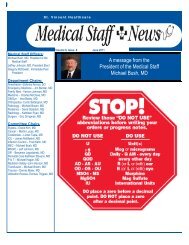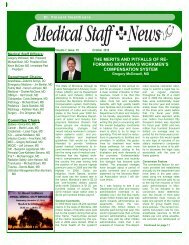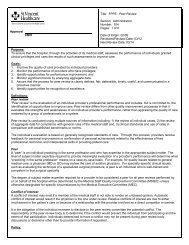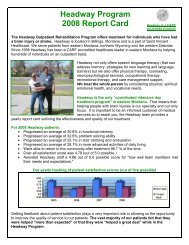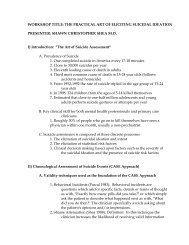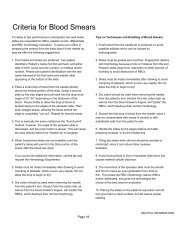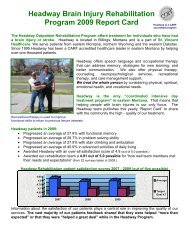AHA/ASA Guideline Guidelines for the Prevention of Stroke in ...
AHA/ASA Guideline Guidelines for the Prevention of Stroke in ...
AHA/ASA Guideline Guidelines for the Prevention of Stroke in ...
Create successful ePaper yourself
Turn your PDF publications into a flip-book with our unique Google optimized e-Paper software.
248 <strong>Stroke</strong> January 2011results <strong>of</strong> MATCH do not suggest a similar risk-benefit ratio<strong>for</strong> patients with stroke and TIA who start <strong>the</strong>rapy beyond <strong>the</strong>acute period.Comb<strong>in</strong>ation clopidogrel and aspir<strong>in</strong> has been comparedwith aspir<strong>in</strong> alone <strong>in</strong> 2 secondary prevention trials: 1 small 314and 1 large. 315 Nei<strong>the</strong>r demonstrated a benefit from comb<strong>in</strong>ation<strong>the</strong>rapy. The Clopidogrel <strong>for</strong> High A<strong>the</strong>rothromboticRisk and Ischemic Stabilization, Management, and Avoidance(CHARISMA) trial 315 enrolled 15 603 patients withcl<strong>in</strong>ically evident cardiovascular disease or multiple riskfactors. After a median <strong>of</strong> 28 months <strong>the</strong> primary outcome(MI, stroke, or death due to cardiovascular causes) wasobserved <strong>in</strong> 6.8% <strong>of</strong> patients assigned to comb<strong>in</strong>ation <strong>the</strong>rapycompared with 7.3% assigned to aspir<strong>in</strong> (RR, 0.93; 95% CI,0.83 to 1.05; P0.22). An analysis among <strong>the</strong> subgroup <strong>of</strong>patients who entered after a stroke showed <strong>in</strong>creased bleed<strong>in</strong>grisk but no statistically significant benefit <strong>of</strong> comb<strong>in</strong>ation<strong>the</strong>rapy compared with aspir<strong>in</strong> alone. The Fast Assessment <strong>of</strong><strong>Stroke</strong> and Transient ischemic attack to prevent Early Recurrence(FASTER) trial 314 was designed to test <strong>the</strong> effectiveness<strong>of</strong> comb<strong>in</strong>ation <strong>the</strong>rapy compared with aspir<strong>in</strong> alone <strong>for</strong>prevent<strong>in</strong>g stroke among patients with a TIA or m<strong>in</strong>or strokewith<strong>in</strong> <strong>the</strong> previous 24 hours. The trial was stopped earlybecause <strong>of</strong> slow recruitment. Results were <strong>in</strong>conclusive.Selection <strong>of</strong> Oral Antiplatelet TherapyThe evidence described above <strong>in</strong>dicates that aspir<strong>in</strong>, ticlopid<strong>in</strong>e,and <strong>the</strong> comb<strong>in</strong>ation <strong>of</strong> aspir<strong>in</strong> and dipyridamole areeach effective <strong>for</strong> secondary stroke prevention. No studieshave compared clopidogrel with placebo, and studies compar<strong>in</strong>git with o<strong>the</strong>r antiplatelet agents have not clearlyestablished that it is superior to or even equivalent to any one<strong>of</strong> <strong>the</strong>m. Observation <strong>of</strong> <strong>the</strong> survival curves from CAPRIEand PRoFESS <strong>in</strong>dicate that it is probably as effective asaspir<strong>in</strong> and comb<strong>in</strong>ation aspir<strong>in</strong>/dipyridamole, respectively.Selection among <strong>the</strong>se 4 agents should be based on relativeeffectiveness, safety, cost, patient characteristics, and patientpreference. The comb<strong>in</strong>ation <strong>of</strong> aspir<strong>in</strong> and dipyridamole maybe more effective than aspir<strong>in</strong> alone <strong>for</strong> prevention <strong>of</strong>recurrent stroke 311 and <strong>the</strong> comb<strong>in</strong>ation <strong>of</strong> stroke, MI, death,or major bleed<strong>in</strong>g. 312 On average, compared with aspir<strong>in</strong>alone, <strong>the</strong> comb<strong>in</strong>ation may prevent 1 event among 100patients treated <strong>for</strong> 1 year. 312 Ticlopid<strong>in</strong>e may be moreeffective than aspir<strong>in</strong> <strong>for</strong> secondary prevention, 301 but safetyconcerns limit its cl<strong>in</strong>ical value.Risk <strong>for</strong> gastro<strong>in</strong>test<strong>in</strong>al hemorrhage or o<strong>the</strong>r major hemorrhagemay be greater <strong>for</strong> aspir<strong>in</strong> or comb<strong>in</strong>ation aspir<strong>in</strong>/dipyridamolethan <strong>for</strong> clopidogrel. 298,304 The difference issmall, however, amount<strong>in</strong>g to 1 major hemorrhage event per500 patient-years. 304 The risk appears to be similar <strong>for</strong> aspir<strong>in</strong>at doses <strong>of</strong> 50 mg to 75 mg compared with <strong>the</strong> comb<strong>in</strong>ation<strong>of</strong> aspir<strong>in</strong>/dipyridamole. However, <strong>the</strong> comb<strong>in</strong>ation <strong>of</strong> aspir<strong>in</strong>/dipyridamoleis less well tolerated than ei<strong>the</strong>r aspir<strong>in</strong> orclopidogrel, primarily because <strong>of</strong> headache. Ticlopid<strong>in</strong>e isassociated with thrombotic thrombocytopenic purpura andshould be used only cautiously <strong>in</strong> patients who cannot tolerateo<strong>the</strong>r agents.In terms <strong>of</strong> cost, aspir<strong>in</strong> is by far <strong>the</strong> least expensive agent.The cost <strong>of</strong> aspir<strong>in</strong> at acquisition is at least 20 times less thanany <strong>of</strong> <strong>the</strong> o<strong>the</strong>r 3 options.Patient characteristics that may affect choice <strong>of</strong> agent<strong>in</strong>clude tolerance <strong>of</strong> specific agents and comorbid illness. Forpatients who cannot tolerate aspir<strong>in</strong> because <strong>of</strong> allergy orgastro<strong>in</strong>test<strong>in</strong>al side effects, clopidogrel is an appropriatechoice. For patients who do not tolerate dipyridamole because<strong>of</strong> headache, ei<strong>the</strong>r aspir<strong>in</strong> or clopidogrel is appropriate. Thecomb<strong>in</strong>ation <strong>of</strong> aspir<strong>in</strong> and clopidogrel may be appropriate<strong>for</strong> patients with acute coronary syndromes 306 or recentvascular stent<strong>in</strong>g. 306,316Selection <strong>of</strong> Antiplatelet Agents <strong>for</strong> Patients WhoExperience a <strong>Stroke</strong> While on TherapyPatients who present with a first or recurrent stroke arecommonly already on antiplatelet <strong>the</strong>rapy. Un<strong>for</strong>tunately,<strong>the</strong>re have been no cl<strong>in</strong>ical trials to <strong>in</strong>dicate that switch<strong>in</strong>gantiplatelet agents reduces <strong>the</strong> risk <strong>for</strong> subsequent events.B. Oral AnticoagulantsRandomized trials have addressed <strong>the</strong> use <strong>of</strong> oral anticoagulantsto prevent recurrent stroke among patients with noncardioembolicstroke, <strong>in</strong>clud<strong>in</strong>g strokes caused by large-arteryextracranial or <strong>in</strong>tracranial a<strong>the</strong>rosclerosis, small penetrat<strong>in</strong>gartery disease, and cryptogenic <strong>in</strong>farcts. The <strong>Stroke</strong> <strong>Prevention</strong><strong>in</strong> Reversible Ischemia Trial (SPIRIT) was stopped earlybecause <strong>of</strong> <strong>in</strong>creased bleed<strong>in</strong>g among those treated withhigh-<strong>in</strong>tensity oral anticoagulation (INR 3.0 to 4.5) comparedwith aspir<strong>in</strong> (30 mg/d) <strong>in</strong> 1316 patients. 317,318 The trial was<strong>the</strong>n re<strong>for</strong>mulated as ESPRIT, us<strong>in</strong>g a medium-<strong>in</strong>tensitywarfar<strong>in</strong> dose (INR 2.0 to 3.0) compared with ei<strong>the</strong>r aspir<strong>in</strong>alone (30 mg to 325 mg daily) or aspir<strong>in</strong> plus extendedreleasedipyridamole 200 mg twice daily. The trial was aga<strong>in</strong>ended early due to <strong>the</strong> superiority demonstrated by <strong>the</strong>comb<strong>in</strong>ation <strong>of</strong> aspir<strong>in</strong> and dipyridamole over aspir<strong>in</strong>alone. 312 Mean follow-up was 4.6 years and mean INRachieved was 2.57. Patients treated with warfar<strong>in</strong> experienceda significantly higher rate <strong>of</strong> major bleed<strong>in</strong>g (HR, 2.56; 95%CI, 1.48 to 4.43) but lower rate, albeit not statisticallysignificant, <strong>in</strong> ischemic events (HR, 0.73; 95% CI, 0.52 to1.01) 319 compared with aspir<strong>in</strong> alone.The ESPRIT results confirmed those reported earlier by <strong>the</strong>Warfar<strong>in</strong> Aspir<strong>in</strong> Recurrent <strong>Stroke</strong> Study (WARSS), <strong>in</strong> whichwarfar<strong>in</strong> (INR 1.4 to 2.8) was compared with aspir<strong>in</strong> (325 mgdaily) among 2206 patients with a noncardioembolic stroke. 320This randomized, double-bl<strong>in</strong>d, multicenter trial found nosignificant difference between treatments <strong>for</strong> prevention <strong>of</strong>recurrent stroke or death (warfar<strong>in</strong>, 17.8%; aspir<strong>in</strong>, 16.0%). Incontrast to ESPRIT, rates <strong>of</strong> major bleed<strong>in</strong>g were not significantlydifferent between <strong>the</strong> warfar<strong>in</strong> and aspir<strong>in</strong> groups(2.2% and 1.5% per year, respectively). A variety <strong>of</strong> subgroupswere evaluated, with no clear evidence <strong>of</strong> efficacyobserved across basel<strong>in</strong>e stroke subtypes, <strong>in</strong>clud<strong>in</strong>g largearterya<strong>the</strong>rosclerotic and cryptogenic categories. The a<strong>for</strong>ementionedWASID trial compared warfar<strong>in</strong> with aspir<strong>in</strong> <strong>in</strong>patients with <strong>in</strong>tracranial stenoses and found no significantbenefit and a higher risk <strong>of</strong> hemorrhage with warfar<strong>in</strong> <strong>the</strong>rapy(see “Intracranial A<strong>the</strong>rosclerosis”).The role <strong>of</strong> anticoagulation <strong>for</strong> specific stroke etiologies isdescribed elsewhere <strong>in</strong> this document.Downloaded from stroke.ahajournals.org by on March 8, 2011



